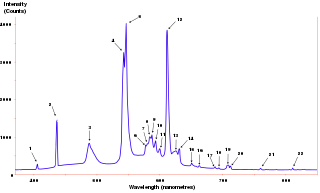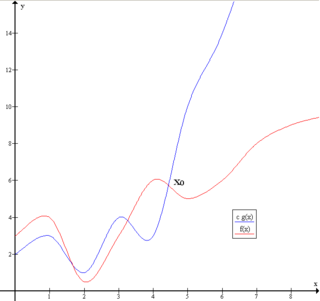
In mathematics, real analysis is the branch of mathematical analysis that studies the behavior of real numbers, sequences and series of real numbers, and real-valued functions. Some particular properties of real-valued sequences and functions that real analysis studies include convergence, limits, continuity, smoothness, differentiability and integrability.

In mathematics, the Dirac delta function is a generalized function or distribution introduced by the physicist Paul Dirac. It is used to model the density of an idealized point mass or point charge as a function equal to zero everywhere except for zero and whose integral over the entire real line is equal to one. As there is no function that has these properties, the computations made by the theoretical physicists appeared to mathematicians as nonsense until the introduction of distributions by Laurent Schwartz to formalize and validate the computations. As a distribution, the Dirac delta function is a linear functional that maps every function to its value at zero. The Kronecker delta function, which is usually defined on a discrete domain and takes values 0 and 1, is a discrete analog of the Dirac delta function.

The Heaviside step function, or the unit step function, usually denoted by H or θ, is a discontinuous function, named after Oliver Heaviside (1850–1925), whose value is zero for negative arguments and one for positive arguments. It is an example of the general class of step functions, all of which can be represented as linear combinations of translations of this one.

The power spectrum of a time series describes the distribution of power into frequency components composing that signal. According to Fourier analysis, any physical signal can be decomposed into a number of discrete frequencies, or a spectrum of frequencies over a continuous range. The statistical average of a certain signal or sort of signal as analyzed in terms of its frequency content, is called its spectrum.

The short-time Fourier transform (STFT), is a Fourier-related transform used to determine the sinusoidal frequency and phase content of local sections of a signal as it changes over time. In practice, the procedure for computing STFTs is to divide a longer time signal into shorter segments of equal length and then compute the Fourier transform separately on each shorter segment. This reveals the Fourier spectrum on each shorter segment. One then usually plots the changing spectra as a function of time.
In mathematics, the discrete-time Fourier transform (DTFT) is a form of Fourier analysis that is applicable to a sequence of values.
The Havriliak–Negami relaxation is an empirical modification of the Debye relaxation model in electromagnetism. Unlike the Debye model, the Havriliak–Negami relaxation accounts for the asymmetry and broadness of the dielectric dispersion curve. The model was first used to describe the dielectric relaxation of some polymers, by adding two exponential parameters to the Debye equation:
In calculus, Leibniz's rule for differentiation under the integral sign, named after Gottfried Leibniz, states that for an integral of the form
Dynamic modulus is the ratio of stress to strain under vibratory conditions. It is a property of viscoelastic materials.
Lévy's modulus of continuity theorem is a theorem that gives a result about an almost sure behaviour of an estimate of the modulus of continuity for Wiener process, that is used to model what's known as Brownian motion.

In mathematics, classical Wiener space is the collection of all continuous functions on a given domain, taking values in a metric space. Classical Wiener space is useful in the study of stochastic processes whose sample paths are continuous functions. It is named after the American mathematician Norbert Wiener.
In approximation theory, Jackson's inequality is an inequality bounding the value of function's best approximation by algebraic or trigonometric polynomials in terms of the modulus of continuity or modulus of smoothness of the function or of its derivatives. Informally speaking, the smoother the function is, the better it can be approximated by polynomials.
In mathematics, uniform integrability is an important concept in real analysis, functional analysis and measure theory, and plays a vital role in the theory of martingales. The definition used in measure theory is closely related to, but not identical to, the definition typically used in probability.
The narrow escape problem is a ubiquitous problem in biology, biophysics and cellular biology.
In mathematics, the Dini–Lipschitz criterion is a sufficient condition for the Fourier series of a periodic function to converge uniformly at all real numbers. It was introduced by Ulisse Dini (1872), as a strengthening of a weaker criterion introduced by Rudolf Lipschitz (1864). The criterion states that the Fourier series of a periodic function f converges uniformly on the real line if
The spectrum of a chirp pulse describes its characteristics in terms of its frequency components. This frequency-domain representation is an alternative to the more familiar time-domain waveform, and the two versions are mathematically related by the Fourier transform.
The spectrum is of particular interest when pulses are subject to signal processing. For example, when a chirp pulse is compressed by its matched filter, the resulting waveform contains not only a main narrow pulse but, also, a variety of unwanted artifacts many of which are directly attributable to features in the chirp's spectral characteristics.
The simplest way to derive the spectrum of a chirp, now that computers are widely available, is to sample the time-domain waveform at a frequency well above the Nyquist limit and call up an FFT algorithm to obtain the desired result. As this approach was not an option for the early designers, they resorted to analytic analysis, where possible, or to graphical or approximation methods, otherwise. These early methods still remain helpful, however, as they give additional insight into the behavior and properties of chirps.
The generalized-strain mesh-free (GSMF) formulation is a local meshfree method in the field of numerical analysis, completely integration free, working as a weighted-residual weak-form collocation. This method was first presented by Oliveira and Portela (2016), in order to further improve the computational efficiency of meshfree methods in numerical analysis. Local meshfree methods are derived through a weighted-residual formulation which leads to a local weak form that is the well known work theorem of the theory of structures. In an arbitrary local region, the work theorem establishes an energy relationship between a statically-admissible stress field and an independent kinematically-admissible strain field. Based on the independence of these two fields, this formulation results in a local form of the work theorem that is reduced to regular boundary terms only, integration-free and free of volumetric locking.















